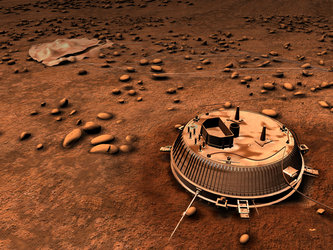Huygens descent timeline
Timeline of events during the Huygens descent to the surface of Titan today. Video status reports
| Time (CET) | Event |
| 6.51 | Timer triggers power-up of onboard electronics Triggered by a pre-set timer, Huygens's onboard electronics power up and the transmitter is set into low-power mode, awaiting the start of transmission. |
| 11.13 | Huygens reaches 'interface altitude' The 'interface altitude' is defined as 1270 kilometres above the surface of the moon where entry into Titan's atmosphere takes place. |
| 11.17 | Pilot parachute deploys The parachute deploys when Huygens detects that it has slowed to 400 metres per second, at about 180 kilometres above Titan's surface. The pilot parachute is the probe's smallest, only 2.6 metres in diameter. Its sole purpose is to pull off the probe's rear cover, which protected Huygens from the frictional heat of entry. 2.5 seconds after the pilot parachute is deployed, the rear cover is released and the pilot parachute is pulled away. The main parachute, which is 8.3 metres in diameter, unfurls. |
| 11.18 | Huygens begins transmitting to Cassini and front shield released At about 160 kilometres above the surface, the front shield is released. 42 seconds after the pilot parachute is deployed, inlet ports are opened up for the Gas Chromatograph Mass Spectrometer and Aerosol Collector Pyrolyser instruments, and booms are extended to expose the Huygens Atmospheric Structure Instruments. The Descent Imager/Spectral Radiometer will capture its first panorama, and it will continue capturing images and spectral data throughout the descent. The Surface Science Package will also be switched on, measuring atmospheric properties. |
| 11.32 | Main parachute separates and drogue parachute deploys The drogue parachute is 3 metres in diameter. At this level in the atmosphere, about 125 kilometres in altitude, the large main parachute would slow Huygens down so much that the batteries would not last for the entire descent to the surface. The drogue parachute will allow it to descend at the right pace to gather the maximum amount of data. |
| 11.49 | Surface proximity sensor activated Until this point, all of Huygens's actions have been based on clock timers. At a height of 60 kilometres, it will be able to detect its own altitude using a pair of radar altimeters, which will be able to measure the exact distance to the surface. The probe will constantly monitor its spin rate and altitude and feed this information to the science instruments. All times after this are approximate. |
| 12.57 | Gas Chromatograph Mass Spectrometer begins sampling atmosphere This is the last of Huygens's instruments to be activated fully. The descent is expected to take 137 minutes in total, plus or minus 15 minutes. Throughout its descent, the spacecraft will continue to spin at a rate of between 1 and 20 rotations per minute, allowing the camera and other instruments to see the entire panorama around the descending spacecraft. |
| 13.30 | Descent Imager/Spectral Radiometer lamp turned on Close to the surface, Huygens's camera instrument will turn on a light. The light is particularly important for the 'Spectral Radiometer' part of the instrument to determine the composition of Titan's surface accurately. |
| 13.34 | Surface touchdown This time may vary by plus or minus 15 minutes depending on how Titan's atmosphere and winds affect Huygens's parachuting descent. Huygens will hit the surface at a speed of 5-6 metres per second. Huygens could land on a hard surface of rock or ice or possibly land on an ethane sea. In either case, Huygens's Surface Science Package is designed to capture every piece of information about the surface that can be determined in the three remaining minutes that Huygens is designed to survive after landing. |
| 15.44 | Cassini stops collecting data Huygens's landing site drops below Titan's horizon as seen by Cassini and the orbiter stops collecting data. Cassini will listen for Huygens's signal as long as there is the slightest possibility that it can be detected. Once Huygens's landing site disappears below the horizon, there's no more chance of signal, and Huygens's work is finished. |
| 16.14 | First data sent to Earth Cassini first turns its high-gain antenna to point towards Earth and then sends the first packet of data. Getting data from Cassini to Earth is now routine, but for the Huygens mission, additional safeguards are put in place to make sure that none of Huygens's data are lost. Giant radio antennas around the world will listen for Cassini as the orbiter relays repeated copies of Huygens data. |
All times above are 'Earth Received' time - i.e. 67 minutes after the actual events have taken place at the spacecraft.















 Germany
Germany
 Austria
Austria
 Belgium
Belgium
 Denmark
Denmark
 Spain
Spain
 Estonia
Estonia
 Finland
Finland
 France
France
 Greece
Greece
 Hungary
Hungary
 Ireland
Ireland
 Italy
Italy
 Luxembourg
Luxembourg
 Norway
Norway
 The Netherlands
The Netherlands
 Poland
Poland
 Portugal
Portugal
 Czechia
Czechia
 Romania
Romania
 United Kingdom
United Kingdom
 Slovenia
Slovenia
 Sweden
Sweden
 Switzerland
Switzerland































